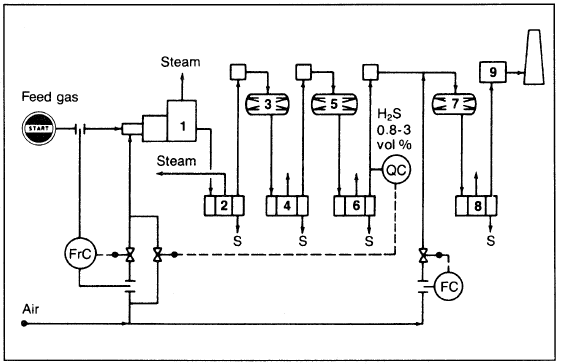

علم الكيمياء

تاريخ الكيمياء والعلماء المشاهير

التحاضير والتجارب الكيميائية

المخاطر والوقاية في الكيمياء

اخرى

مقالات متنوعة في علم الكيمياء

كيمياء عامة


الكيمياء التحليلية

مواضيع عامة في الكيمياء التحليلية

التحليل النوعي والكمي

التحليل الآلي (الطيفي)

طرق الفصل والتنقية


الكيمياء الحياتية

مواضيع عامة في الكيمياء الحياتية

الكاربوهيدرات

الاحماض الامينية والبروتينات

الانزيمات

الدهون

الاحماض النووية

الفيتامينات والمرافقات الانزيمية

الهرمونات


الكيمياء العضوية

مواضيع عامة في الكيمياء العضوية

الهايدروكاربونات

المركبات الوسطية وميكانيكيات التفاعلات العضوية

التشخيص العضوي

تجارب وتفاعلات في الكيمياء العضوية


الكيمياء الفيزيائية

مواضيع عامة في الكيمياء الفيزيائية

الكيمياء الحرارية

حركية التفاعلات الكيميائية

الكيمياء الكهربائية


الكيمياء اللاعضوية

مواضيع عامة في الكيمياء اللاعضوية

الجدول الدوري وخواص العناصر

نظريات التآصر الكيميائي

كيمياء العناصر الانتقالية ومركباتها المعقدة


مواضيع اخرى في الكيمياء

كيمياء النانو

الكيمياء السريرية

الكيمياء الطبية والدوائية

كيمياء الاغذية والنواتج الطبيعية

الكيمياء الجنائية


الكيمياء الصناعية

البترو كيمياويات

الكيمياء الخضراء

كيمياء البيئة

كيمياء البوليمرات

مواضيع عامة في الكيمياء الصناعية

الكيمياء الاشعاعية والنووية
THE CLAUS PROCESS
المؤلف:
sami matar & Lewis. F. Hatch
المصدر:
Chemistry of PETROCHEMICAL PROCESSES
الجزء والصفحة:
p 116
6-8-2017
1575
THE CLAUS PROCESS
This process includes two main sections: the burner section with a reaction chamber that does not have a catalyst, and a Claus reactor section.
In the burner section, part of the feed containing hydrogen sulfide and some hydrocarbons is burned with a limited amount of air. The two main reactions that occur in this section are the complete oxidation of part of the hydrogen sulfide (feed) to sulfur dioxide and water and the partial oxidation of another part of the hydrogen sulfide to sulfur. The two reactions are exothermic:

In the second section, unconverted hydrogen sulfide reacts with the produced sulfur dioxide over a bauxite catalyst in the Claus reactor.
Normally more than one reactor is available. In the Super-Claus process (Figure 4-3), three reactors are used. The last reactor contains a selective oxidation catalyst of high efficiency. The reaction is slightly exothermic:


Figure 1.1. The Super Claus process for producing sulfur: (1) main burner, (2,4, 6,8) condensers, (3,5) Claus reactors, (7) reactor with selective oxidation catalyst.
After each reaction stage, sulfur is removed by condensation so that it does not collect on the catalyst. The temperature in the catalytic converter should be kept over the dew point of sulfur to prevent condensation on the catalyst surface, which reduces activity.
Due to the presence of hydrocarbons in the gas feed to the burner section, some undesirable reactions occur, such as the formation of carbon disulfide (CS2) and carbonyl sulfide (COS). A good catalyst has a high activity toward H2S conversion to sulfur and a reconversion of COS and
CS2 to sulfur and carbon oxides. Mercaptans in the acid gas feed results in an increase in the air demand. For example, approximately 5–13%
increase in the air required is anticipated if about 2 mol% mercaptans are present. The increase in the air requirement is essentially a function of the type of mercaptans present. The oxidation of mercaptans could be represented as:

Sulfur dioxide is then reduced in the Claus reactor to elemental sulfur.
 الاكثر قراءة في البترو كيمياويات
الاكثر قراءة في البترو كيمياويات
 اخر الاخبار
اخر الاخبار
اخبار العتبة العباسية المقدسة

الآخبار الصحية















 "المهمة".. إصدار قصصي يوثّق القصص الفائزة في مسابقة فتوى الدفاع المقدسة للقصة القصيرة
"المهمة".. إصدار قصصي يوثّق القصص الفائزة في مسابقة فتوى الدفاع المقدسة للقصة القصيرة (نوافذ).. إصدار أدبي يوثق القصص الفائزة في مسابقة الإمام العسكري (عليه السلام)
(نوافذ).. إصدار أدبي يوثق القصص الفائزة في مسابقة الإمام العسكري (عليه السلام) قسم الشؤون الفكرية يصدر مجموعة قصصية بعنوان (قلوب بلا مأوى)
قسم الشؤون الفكرية يصدر مجموعة قصصية بعنوان (قلوب بلا مأوى)


















